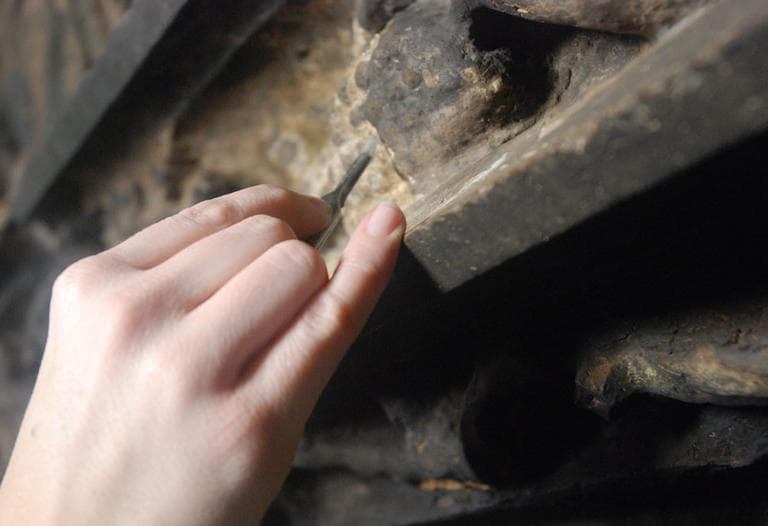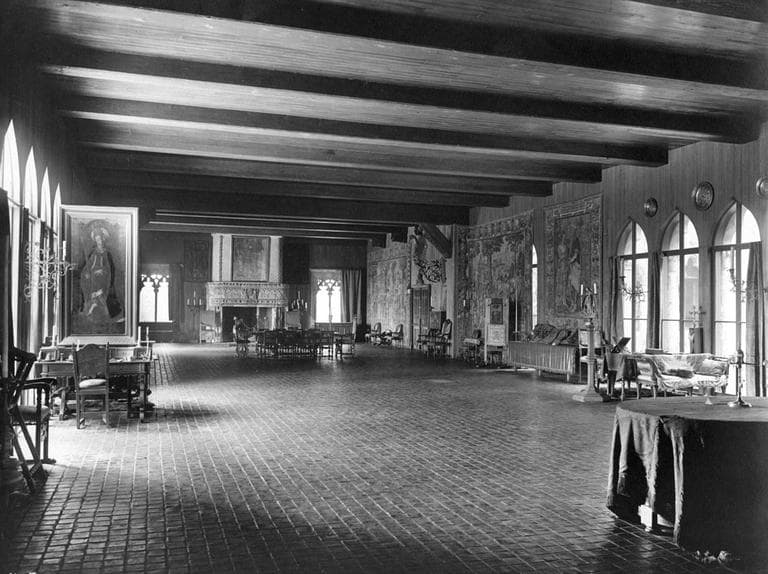Advertisement
Gardner Undergoes Both Preservation, Expansion
The Isabella Stewart Gardner Museum is in the middle of an ambitious $180 million upgrade. But because its namesake left explicit instructions that nothing be altered after her death, the changes underway have raised some questions. I visited the Gardner to get some answers — and a progress report.
The transition is really two projects — the restoration of the Gardner’s historic Venetian palace, and the construction of a new, strikingly different addition just 50 feet away. But a certain yin and yang is at play here between the old and the contemporary, according to project director James Labeck.
“Even the construction workers are going back and forth between the two,” Labeck said. "They’re working on both spaces, it’s all one project.” Building the new glass and steel structure is the expansion part of the equation. Restoring galleries and reclaiming space in the old museum is the other. This month work inside Gardner's grand Tapestry Room is kicking into high gear, where extremely delicate acts of preservation are taking place.

A conservation team wielding scalpels and paint brushes gently cleans a 15th century French fireplace installed when Gardner lived in the palace. Bright spotlights illuminate layers of caked-on soot and grime. Senior Objects Conservator Valentine Talland leans down and admits the team has never had the chance to examine the ornate fireplace this carefully.
"When we first started looking at it, because it’s so dark here and you can’t get that close to it, none of us were aware that it was painted,” she recalled with a laugh. “So that was our first happy discovery. And just the nature of the carving, the figures are very sweet, and it’s a beautiful composition.”
Fact is, the medieval carvings have been hidden from view for decades behind a good-sized performance stage. That platform was taken out of the Tapestry Room in December. Its removal has changed the overall look and feel of the 4,000-square foot space.
Seeing the hall opened-up has been a revelation for Museum Director Anne Hawley.
Advertisement
“It’s been three generations of people that have never seen it like this,” she said, “because it’s been since 1925 that it’s been set up as a venue for gatherings.”
After Gardner died in 1924 the Tapestry Room became a buzzing center of cultural activity, according to Hawley, and it has been ever since. In 2010, for instance, 50 concerts took place in this room. Approximately 10,000 people came and went over the course of the year. In 1965 the volume was even greater, with 196 performances.
"So it was always set up with chairs and you could never really see things all that well,” Hawley said. But not anymore. “We are off-loading all these concerts and lectures and events into the new addition, and this becomes restored to the great Tapestry Hall that it was.”
It will take more than six months to get the expansive room back to exactly the way it was in Gardner’s day. Everything in it is being cleaned and restored — the Belgian tapestries, the hand-crafted tiles, the furniture and the art on the walls.
Gianfranco Pocobene, head of conservation at the Gardner, is working on a six-foot-tall painting of the Archangel Michael by Pedro Garcia de Benabarre dated 1470. It's propped up just a few feet from the fireplace, and has been off-view to the public since last year. Pocobene is sprucing it up on-site in the Tapestry Room because the museum's old conservation labs have been dismantled and the new ones have yet to be built in the addition.
Pocobene and Hawley showed me photographs of the Tapestry Room that were taken in the 1920s when Gardner was still alive. They're using them as reference points so they can replicate the placement of every single item in the hall. Antique chairs that were pushed to the side long ago will be re-set where the stage used to be, along with a stunning table.

But all of these changes — or reversals — raise a question:
If nothing is ever supposed to be modified in Isabella Stewart Gardner's palace, how did the Tapestry Room become a performance venue, with a stage, in the first place?
Hawley says museum trustees petitioned state courts after Gardner died nearly 80 years ago, asking to continue hosting concerts here — as she did in life — but on a larger scale.
“And the argument to the court was in order to be a public museum now that she was no longer living here, they needed the space,” Hawley said. They were granted permission. Hawley, curators, conservators and trustees made their own case to convince the Supreme Judicial Court — and critics — that the current expansion project was necessary to preserve the historic palace. They argued that a new building would take stress off the old structure, diverting foot traffic with its cafe, shop, artist apartments and a state-of-the art concert hall. This brings us to where the Gardner is today.
Project director Labeck took me on a tour of the museum's new addition. Right now it's an impressive work-in-progress. From outside the building's glass and steel skeleton looks nearly complete, but inside its operational guts are being installed. Electrical wiring and ventilation ducts are exposed. Labeck took me upstairs to the new music venue on the second floor.
“It’s a very intimate, three-story, 300-person performance space,” Labeck said, although right now the room is a big, very interesting-looking cement box. When it's finished it will be acoustically pristine, according to Labeck. Then, as if on cue, the construction workers made their own kind of music as they pulled up a mass of temporary plywood floorboards.
Next we visited the Gardner's new art gallery. We could see the old building looking back at us through the thick, glass wall. Labeck believes there’s a dialogue between the two structures, but he also said working on them simultaneously can be a sensitive balancing act. Everyone is hyper-aware of Isabella Stewart Gardner's precious palazzo.
"Having the messy parts of construction next door, the noisy, percussive parts of construction next door — you know we drove piles, and sheet piles over a year ago — all these things you hear them, we feel them every once in a while, but we certainly monitor them very carefully for their impact on the historic building," he said. "It’s careful work.”
Even though it might not sound very careful right now. Hammering and powertools echo throughout the addition's cavernous space, and clearly there's a ton of work to be done before it will be visitor-ready. But Labeck said the construction and preservation of the "new" Isabella Stewart Gardner Museum is on track for opening in January 2012.
This program aired on January 31, 2011.
